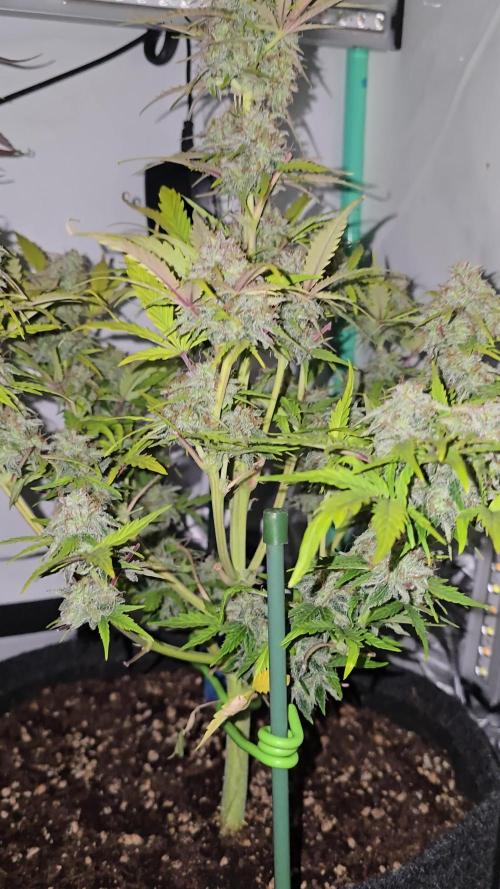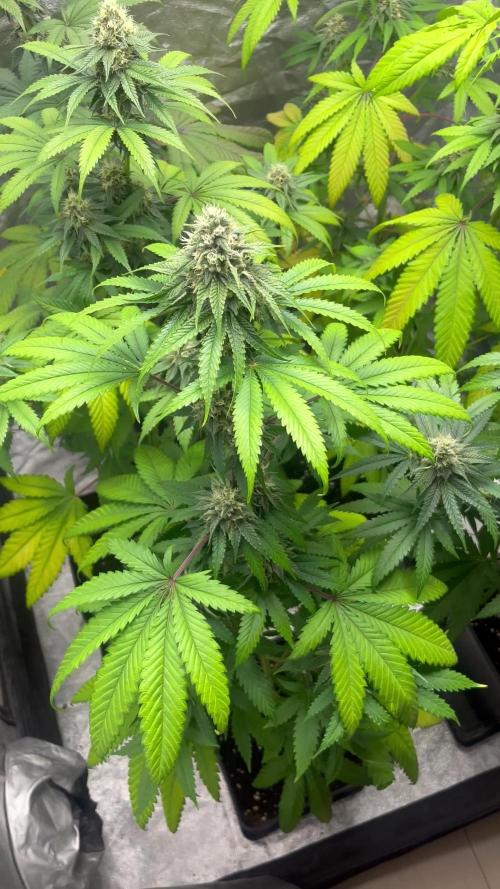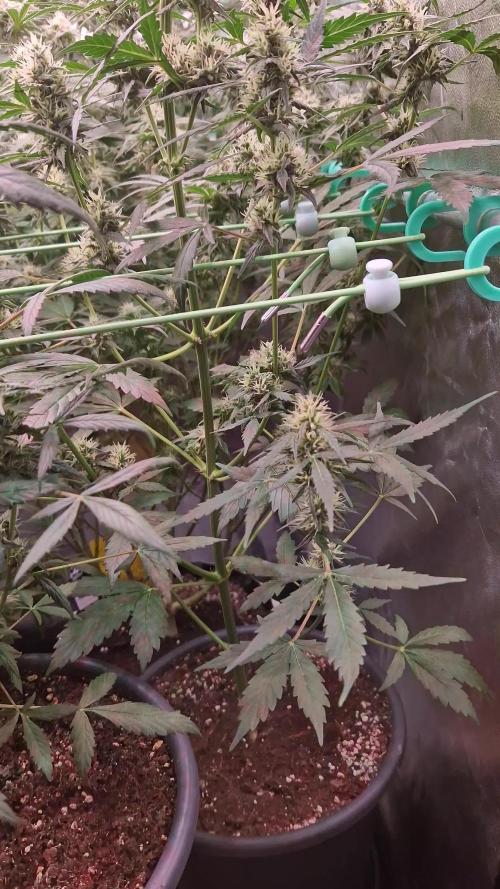The Grow Awards 2026 🏆 



























Likes
12
Share


@Skunkiest_bender39
Follow
Nachts hin und wieder mal den Heizlüfter genutzt um auf 20grad zu heizten. Die Damen wurden die ersten Nächte im WG leider noch vom tv Licht der Eltern bestrahlt (hätte ich drauf kommen müssen hab’s einfach ausgebelendet), und so ist ein bisschen Stress aufgetreten in Form von verlangsamten Wachstum und manche Knollen weisen einzelne Samen auf, habe allerdings bis jetzt nur 5stk gefunden auf alle 4 pflanzen verteilt. Habe Wintergarten zum Haus hin mit Leinen abgehangen. Waren ca 3 Abende bis ca 12uhr bestrahlt. Das umschalten hat ca 7 tage gebraucht. Die Damen setzen jetzt alle samt die knollenstände zu!😇☮️
Likes
7
Share


@KannaKullektiv
Follow
Hiiigh friends 🙌
Welcome to the last week. 🍀
She is harvested, dried and cured. An amazing taste for sure! 🍑
See you next run 👋
Arturo for KannaKullektiv
🙏
Likes
5
Share


@AustinRon
Follow
TH 1Q2025 - Week 5 - Bolt 2
(ON Haze X Original Haze) X Northern Lights #2
“Todd’s Haze”
Objective
- 8 Female Plants, Topped ONCE @ Flip, 12” when topped
- Modified Sea of Green
Seeds Wet: 1139PM, 28.2.2025
Germinated: 2.3.2025
Flip: 21.3.2025
Harvest: 77 Days, DATE: 6.6.2025
Weeks Summary
- Continuing slow increase of EC & PPFD - Achieved EC: 1.8
- Allowing natural PPFD Increase (STRETCH), and providing modicum of intensity increase.
_________________________________________
__
Fri Apr 4, 2025
TH 1Q25 15:B:2:1
Light Intensity: [ 400, µMol/m2/s]
EC: [ 1.1, mS/cm]
Foliar: # 1 pt Spray Bottle @ Lights ON
- [x] CalMag Fuel: [ 2.5, ml]
- [x] Lush Green: [ 0.67, ml]
- [x] Kelpak (Auxins): [ 1, ml]
- [x] Photosynthesis Plus: [ 1.5, ml]
- [x] Quillaja 60 Powder: [scant]
- [x] Fertigation: 5:2:2:2:2:2:0
__
Sat Apr 5, 2025
TH 1Q25 16:B:2:2
EC: 1.3
- [x] EC: 1.3
- [x] Fertigation: [5.8:5.8:2.3:2.3:2.3:2.3:2.3] # [Primer A:Primer B:CalMag Fuel:Silica Skin:Lush Green:Root Anchor:Peak Bloom]
__
Sun Apr 6, 2025
TH 1Q25 17:B:2:3
- [x] EC: 1.4
Foliar: # 1 pt Spray Bottle @ Lights ON
- [x] CalMag Fuel: [ 2.5, ml]
- [x] Lush Green: [ 0.67, ml]
- [x] Kelpak (Auxins): [ 1, ml]
- [x] Photosynthesis Plus: [ 1.5, ml]
- [x] Quillaja 60 Powder: [scant]
- [x] Fertigation: [6.3:6.3:2.5:2.5:2.5:2.5:2.5] # [Primer A:Primer B:CalMag Fuel:Silica Skin:Lush Green:Root Anchor:Peak Bloom]

__
Mon Apr 7, 2025
TH 1Q25 18:B:2:4
EC: 1.5
Raised Dimmer to 77%
LightIntensity: [ 517, µMol/m2/s]
- [x] Fertigation: [6.3:6.3:2.5:2.5:2.5:2.5:2.5] # [Primer A:Primer B:CalMag Fuel:Silica Skin:Lush Green:Root Anchor:Peak Bloom]
__
Tue Apr 8, 2025
TH 1Q25 19:B:2:5
EC: 1.6
LightIntensity: [ 517, µMol/m2/s]
Foliar: # 1 pt Spray Bottle @ Lights ON
- [x] CalMag Fuel: [ 2.5, ml]
- [x] Lush Green: [ 0.67, ml]
- [x] Silica Skin: [ 2, ml]
- [x] Fertigation: [7.1:7.1:3.5:3.5:2.8:2.8:2.8] # [Primer A:Primer B:CalMag Fuel:Silica Skin:Lush Green:Root Anchor:Peak Bloom]
- [x] Terps Plus: [ 0.2, ml]
- [x] Photosynthesis Plus: [ 6, ml]
__
Wed Apr 9, 2025
TH 1Q25 20:B:2:6
Looking Relaxed, Happy, Lifted, Supple.
EC: 1.7
- [x] Fertigation: [7.1:7.1:3.5:3.5:2.8:2.8:2.8] # [Primer A:Primer B:CalMag Fuel:Silica Skin:Lush Green:Root Anchor:Peak Bloom]
- [x] Kelpak: [ 4, ml]
- [x] Photosynthesis Plus: [ 6, ml]
- [x] Terps Plus: [ 0.2, ml]
- [x] Quillaja 60 Powder: [scant]
__
Thu Apr 10, 2025
TH 1Q25 21:B:2:7
Light Distance: [ 23, in]
HOME Depot Run
- [x] Tube Insulation (Re-Fresh Chiller Insulation)
EC: 1.8 # MAX EC for GROW
Foliar: # 1 pt Spray Bottle @ Lights ON
- [x] CAL106 (Micronized Calcium Carbonate): [ 0.125, g]
- [x] Lush Green: [ 0.67, ml]
- [x] Kelpak (Auxins): [ 1, ml]
- [x] Photosynthesis Plus: [ 1.5, ml]
- [x] Quillaja 60 Powder: [scant]
- [x] Fertigation: [8:8:4.8:4.8:3.2:3.2:0.0:0.0:3.2] # [Primer A:Primer B:CalMag Fuel:Silica Skin:Lush Green:Root Anchor:Peak Bloom]
- [x] PCAL 1660: [ 0.5, gm] # Once or Twice/Week
- [x] Kelpak: [ 4, ml]
- [x] Photosynthesis Plus: [ 6, ml]
- [x] Terps Plus: [ 0.2, ml]
- [x] Quillaja 60 Powder: [scant]
Likes
Comments
Share


@UkCaliGrower
Follow
Beautiful Lemon Kush by female seeds😍all of the airy buds went in with trim to create some CannaButter😍 there is 5oz from wetness, hopefully cure 2oz. Next ones are purple lemonade by fast buds
Likes
28
Share


@Bread_n_Buds
Follow
The Lavender by Seeds Mafia had some difficulties at the beginning otherwise it would have become even more super, I was wrong but the plant is still nice and produced about 25 grams dry. We like main colas and the cannabis has a nice texture.
https://seedsmafia.com/en/
https://www.mars-hydro.com/
Likes
Comments
Share


@Naujas
Follow
63 dienos!!!! mergytė tuoj pagimdys, būtų buvusi daug gražesnė, bet padariau klaidų, iš kurių pasimokiau ir ateityje nekartosiu:) sėkmės visoms :).
Likes
11
Share


@eldruida_lamota
Follow
Vamos familia, actualizamos la quinta semana de floración de estas Lemon Cherry Runtz de FastBuds.
La temperatura que estuvo entre los 24-26 grados y humedad dentro de los rangos correctos.
En cuanto a las plantas las veo verde sano, estiraron bien y ensancharon bastante también.
Se nota que los nutrientes de la marca Agrobeta cubre todas las necesidades de cada ejemplar, también añadí Thor y Mega Pk.
Las flores empezaron a tricomar y engordar, por el momento todo correcto, os dejé también alguna novedad y un cambio en la sala, agradecer al equipo de Mars hydro por el nuevo TSW2000. (los últimos 5 años cultive solo con los leds de esta marca) los cuales probé, TS600, TS1000, TS3000, TSL2000.
- os dejo por aquí un CÓDIGO: Eldruida
Descuento para la tienda de MARS HYDRO.
https://www.mars-hydro.com
Hasta aquí todo, Buenos humos 💨💨💨
Likes
27
Share


@420DeepGrow
Follow
Gracias al equipo de Zamnesia Marshydro XpertNutrients y Trolmaster sin ellos esto no sería posible.
💐🍜 Cosmic Noodles:
Orgullosa descendiente de Alien OG y Rollercoaster Haze, la Cosmic Noodles ofrece cosechas excelentes y una experiencia de fumar fragante. Esta variedad es muy potente, tiene un 25% de THC y produce efectos intensos y duraderos. Edificante y relajante, fumar Cosmic Noodles catalizará un colocón cerebral energizante que luego disminuirá hasta convertirse en un relajante colocón corporal.
Aquí se pueden detectar las influencias de ambas cepas parentales y las flores son notablemente cítricas, con la lima en primer plano. También disfrutarás de notas especiadas y terrosas con delicados matices florales.
🌻🚀 Consigue aqui tus semillas:
https://www.zamnesia.com/10777-zamnesia-seeds-cosmic-noodles.html
Código Descuento 20%: ZAMMIGD2023
💡TS-3000 + TS-1000: se usaran dos de las lámparas de la serie TS de Marshydro, para cubrir todas las necesidades de las plantas durante el ciclo de cultivo, uso las dos lámparas en floracion para llegar a toda la carpa de 1.50 x 1.50 x 1.80.
https://marshydro.eu/products/mars-hydro-ts-3000-led-grow-light/
🏠 : Marshydro 1.50 x 1.50 x 1.80, carpa 100% estanca con ventanas laterales para llegar a todos los lugares durante el grow
https://marshydro.eu/products/diy-150x150x200cm-grow-tent-kit
🌬️💨 Marshydro 6inch + filtro carbon para evitar olores indeseables.
https://marshydro.eu/products/ifresh-smart-6inch-filter-kits/
💻 Trolmaster Tent-X TCS-1 como controlador de luz, optimiza tu cultivo con la última tecnología del mercado, desde donde puedes controlar todos los parametros.
https://www.trolmaster.com/Products/Details/TCS-1
🍣🍦🌴 Xpert Nutrients es una empresa especializada en la producción y comercialización de fertilizantes líquidos y tierras, que garantizan excelentes cosechas y un crecimiento activo para sus plantas durante todas las fases de cultivo.
Consigue aqui tus Nutrientes:
https://xpertnutrients.com/es/shop/
📆 Semana 1:
Ha sido una buena semana, ella ha dado otro gran cambio en su lugar definitivo 😎.
La carpa está ocupada al 75% y comienza una floracion explosiva gracias a @Marshydro y @Xpertnutrients y @Trolmaster con esta gran genética 💪.
A partir de ahora se riega manualmente con las dosis recomendadas por el fabricante.
Processing
Likes
1
Share


@blendmedmedman
Follow
she is still up and going and has a cool bluish purple hue going on and is really hard to get a photo. she has been on the flush for 4 weeks now. ice cold water to get those fades. she stinks and would def recommend a carbon filter. until next week. I will be ready when she is ready.
Likes
37
Share


@Ganja_Victoria_Aus
Follow
Last week or so. Almost ready. Last good feeding.
5 jul. Unfortunately my fluence die. Lucky enough got few led hanging in the house and 1 hps 600w. They reaching 7 week of Flowering. Lucky fluence did the job pretty decent size bud all around. ❤️🧘♂️🏻
Likes
1
Share


@Greenpalace_420
Follow
Ya vemos q están desarrollando unas buenas hojas y hemos incorporado 2 esquejes q nos dejo un amigo q estan medios flojitos y vamos a echarlos para adelante seguimos
Likes
17
Share


@CanadianFillmore
Follow
Week 5 begins for Mandarin dreams and Divine storm. All four ladies look happy and healthy with minor deficiency signs. All four are bulking up and frosty as my windows (it's -21 °c)!
The Mars-Hydro TSW2000 is performing awesome, very happy with it. Thank you Kaoritracy for hooking me up!
Thanks for stopping by growfessors 👽🌳💚
Likes
11
Share


@TrickzGrowz
Follow
Ich komm aus den Staunen nicht raus, wie riesig der Headbud jetzt schon ist!
Likes
151
Share


@yan402
Follow
🌸🍊✨🍭🌸🍊✨🍭🌸🍊✨🍭🌸
Back at it with Kannabia — huge thanks for the NEW EXCLUSIVE Upcoming Kannabia's seed Launch 🙏🍨🍊
Grateful for the trust and for everyone following along, I’ll run her clean and showcase what she can do.
Dessert-party goals: berry–citrus sherbet terps, creamy finish, tight stacks, easy trim, zero drama.
Veg 24/0, clean manifold + LST, flip on a happy, even canopy.
Coco’s fresh, seed goes in now. 🚀
Added on 12.10.2025
🌞 Light conditions: Limited direct light for the first 4 weeks — ~4 h/day on weekdays and ~10–11 h on weekends due to tent sharing and work schedule.
🌸🍊✨🍭🌸🍊✨🍭🌸🍊✨🍭🌸
💭❗💭❗💭❗💭❗💭❗💭❗💭
❗Events & thoughts worth noting❗
💭❗💭❗💭❗💭❗💭❗💭❗💭
10.08.25 GW1 Sowed seed, soaked starter pot with #1
12.08.25 GW1 Seed popped hip hip hurray
28.08.25 VW2 Stopped using GreenBuzzBloom, took it out of the schedule.
01.09.25 VW3 TriPartMicro 10→30ml, TriPart bloom 10→30ml
12.09.25 VW4 Applied nemadodes against thrips and fungus gnats.
20.09.25 VW6 topped and trained for first time, decided against a full manifold as I lost a few weeks already.
26.09.25 VW7 Topped her one more time for 8 mains
27.09.25 VW7 Topped up the pot with perlite instead of clay pebbles this time, just trying things out, TriPartMicro 30→40ml , TriPartBloom 30→20ml
10.10.25 VW9 have her a haircut, umm be trimming the side shoots tomorrow, rest in the video 📹
12.10.25 VW9 done some extra trimming to clean up a bit and chose two extra side shoots to nurture info mains, so kept the 8 original mains plus 2 rest in the video 📹
17.10.25 VW9 FfJ/fpj fish mix 30 → 60 ml
20.10.25 VW10 Feed tweak: added 3 g Calcium Nitrate/ 30 L (≈ 15 ppm N + 10 ppm Ca)
24.10.25 VW11 did a defoliation and trimming session 📹
27.10.25 VW11 Epsom Salt 0 → 2.5, Calcium Nitrate 3 → 9 g
01.11.25 VW12 CalMag 60 → 30ml, TriPartBloom 20 → 30ml, Magnesium 2.5 → 3.5g
02.11.25 VW12 Did a cleanup in preparation for flowering, rest in the video 📸
12.11.25 VW13 Did another cleanup in the tent 🎥, also switched to the FERMAKOR PK Micro schedule, (10.11.25) added Phosphoric acid as a pH down in preparation for flowering
14.11.25 FW1 FERMAKOR PK Micros 40 → 50 ml
🌱💦🌱💦🌱💦🌱💦🌱💦🌱
🌿 Day to day tasks & actions 🌿
🌱💦🌱💦🌱💦🌱💦🌱💦🌱
14.11.25 VW13 – Fed 5l of FERMAKOR PK → 2l runoff
15.11.25 FW1 – Fed 5l of #1 → 2l runoff
16.11.25 FW1 – Fed 5l of #1 → 2l runoff
17.11.25 FW1 – Fed 5l of #1 → 2l runoff
18.11.25 FW1 – Fed 5l of #1 → 2l runoff
19.11.25 FW1 – Fed 5l of #1 → 2l runoff
20.11.25 FW1 – Fed 5l of #1 → 2l runoff
21.11.25 FW1 – Fed 5l of #1 → 2l runoff
(*RUNOFF reused for tomato plants)
🍶💧🍶💧🍶💧🍶💧🍶
💧 Nutrients in 30 L #1 Veg — FERMAKOR
🍶💧🍶💧🍶💧🍶💧🍶
💧 Calcium Nitrate (Calcinit / Nitcal): 45 → 40 g
= 1.33 g/L → 207 ppm N + 253 ppm Ca
🍶 PK Concentrate (FERMAKOR Base): 30 → 40 ml
= 1.00 → 1.33 ml/L → balanced 1:1 P:K + light micros (from extract)
💧 Home-made FFJ/FPJ (Fish + Veg): 30 ml
= 1.00 ml/L
🍶 Epsom Salt (MgSO₄·7H₂O): 8 g
= 0.27 g/L → 26 ppm Mg + 35 ppm S
💧 Fetrilon Combi 1 (Micros): 0.5 g
= 0.017 g/L → Fe 0.7 ppm • Mn 0.7 ppm • Zn 0.3 ppm • Cu 0.3 ppm • B 0.1 ppm • Mo 0.02 ppm
🍶Phosphoric Acid (pH down) + Citric Acid (chelation): as needed
→ First set pH with phosphoric acid, then add a little citric only if you want extra chelation
💧 Target pH: 5.8 – 6.0 (drop test yellow-green)
📦 TOTAL: 60 → 70 ml / 48.5 g inputs per 30 L
= 2.00 → 2.33 ml/L + 1.62 g/L
⚙️✂️⚙️✂️⚙️✂️⚙️✂️⚙️
✂️ Tools & equipment ✂️
⚙️✂️⚙️✂️⚙️✂️⚙️✂️⚙️
✂️ 2× MarsHydro SP3000
⚙️ MarsHydro 150mm ACF Ventilator
✂️ Trotec dehumidifier (big unit)
⚙️ Mini no-name dehumidifier
✂️ Kebab skewers (LST – stainless)
⚙️ Wire + roast skewers (LST assist)
✂️ Scissors (HST)
⚙️ Vacuum (for spills & cleanup)
✂️⚙️✂️⚙️✂️⚙️⚙️✂️⚙️✂️⚙️✂️⚙️
---
🍊🍧🌬️🍬🍊🍧🌬️🍬🍊🍧🌬️🍬 Mystery seed (Kannabia Seeds) — NEW EXCLUSIVE
🍊🍧🌬️🍬🍊🍧🌬️🍬🍊🍧🌬️🍬
Species: Hybrid (GF / swift-flowering line)
Genetics: TBA (breeder sheet pending)
THC: TBA
Effect: Euphoric, relaxed, creative (target profile)
Flavor: Berry–citrus sherbet, sweet candy, creamy finish
Flowering (indoors): ~6–7 weeks target (GF)
Resistance: High (aim: no drama)
Indoor yield: TBA
Outdoor yield: TBA
Structure: TBA
Notes: Brand-new exclusive from Kannabia’s GF line — I’ll update specs when the breeder card drops. Goal is rich sherbet terps (berry–citrus + cream), low leaf-to-calyx, easy trim. Stage harvest stays on the table if tops finish early.
YouTube Link: https://youtube.com/-m8h?si=A7x4Zlr2kj-_ga31

























